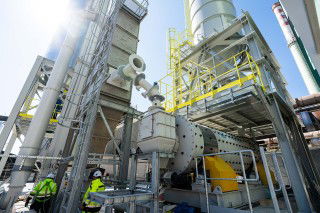The Egyptian government has decided to take direct action to curb the excess production in the country's cement sector. In an attempt to ease the flow of cement, the government has proposed that cement producers reduce their production by 10 per cent. The government itself has contributed to the oversupply with the creation of its 13Mta military plant in Beni Suef cement plant in 2018, which has seen its sales fall by half, according to military executives.
Under the formula proposed last month, each cement maker would cut production by a base amount of 10.52 per cent. They would cut an additional 3.71 per cent for each production line and 0.65 per cent for each year they have been in operation, said one executive. That would amount to a cut of at least 14 per cent, and possibly more than double that for older and bigger plants.
Cement executives from competing companies have spoken out against the proposal, arguing that their plants have existed for longer in the market. Speaking to Reuters, one anonymous cement producer executive said: "It’s very welcome by the industry that there is some sort of intervention by the government," said the second executive. But he added: "We don’t think (the formula) is particularly fair, it’s biased towards some local players at the moment."
Cement companies complained of over-production even before the US$1.1bn Beni Suef plant was built. Egyptian cement capacity has risen to 85Mta to 87Mta in the last three years. Annual cement sales fell to 41.7Mt in 2020 from 43.8Mt in 2019, according to central bank statistics. Moreover, it stood at 49.5Mt in 2017, the year before Beni Suef went online.
The severity of the situation is so critical that, as reported on CemNet, Lafarge Egypt CEO, Solomon Baumgartner Aviles, recently said that five or six companies were likely to leave the sector in 2021 due to the large surplus production.
Foreign companies feeling pushed out
Many foreign cement firms are operating in Egypt's cement sector, including Germany's HeidelbergCement, France's Vicat, Switzerland’s LafargeHolcim, Greece’s Titan Cement and Mexico's Cemex. These multinationals have invested heavily in Egypt after a privatisation drive that began in the 1990s. Domestic producers, including the military, have since been adding new capacity.
Relations between foreign cement producers operating in Egypt and the state have been tested in recent months with Spanish companies Cementos La Unión and Aridos Jativa having had their lawsuit against the Egyptian state rejected last November. The foreign producers had argued that the Egyptian state had not upheld its international obligations and that the state took measures that had allegedly caused damage to their investments in the country.
Greenfield construction continues
Meanwhile, another 2Mta plant will come on-stream this year in Sohag, 400km south of Cairo. The US$285.79m facility, owned by Egyptian Steel, will operate as Egyptian Cement Co. It began trial production in the last few weeks and is due to start shipping soon. The plant has been built by Sinoma-CDI of China and will use the parent company's slag in its cement production.
Keeping utilisation rates under control
A glimmer of hope that the situation might be starting to improve was noted in March this year when cement sales reached 4.99Mt, up 22 per cent MoM and 15 per cent YoY. The utilisation rate also increased to 74 per cent from 60 per cent in February. The average factory utilisation rate was 59 per cent, according to local sources.
The government's attempts to bring supply back in line with demand are long overdue, but it is not clear how this proposal can be accepted by the industry, as longer-term incumbents will be unfairly penalised. A more equitable approach would be to apply progressive environmental targets across the industry and allow the competitive forces eliminate the laggards over time.
